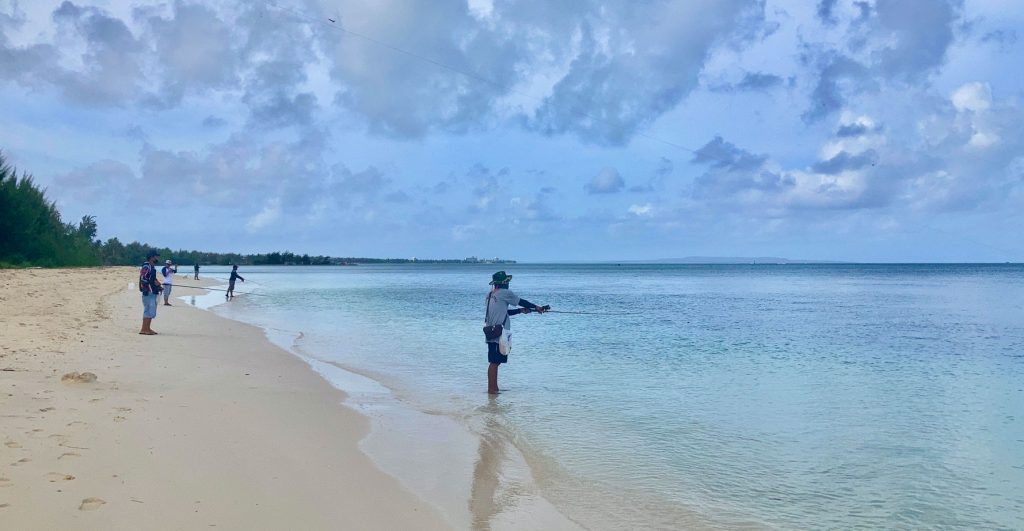Climate study warns of extreme heat in the CNMI

Farmers and fisherfolk will be among those who will be the first to get affected by extreme heat and weather changes in the CNMI. (IVA MAURIN)
Hot days are getting more frequent. Expect it to get even worse.
A 2021 climate assessment report on the CNMI disclosed that the annual number of hot days in the Marianas has increased, and subsequently, the annual number of cool nights has dropped.
According to the report, Climate Change in the Commonwealth of the Northern Mariana Islands: Indicators and Considerations for Key Sectors, air temperature measurements at the Francisco C. Ada/Saipan International Airport from 2006 to 2020, where the number of hot days—90°F and above—are recorded, show an increasing trend.
Compared to fewer than 50 in 2006, hot days on Saipan have ballooned to over 150 last year.
This may sound harmless—like a simple temperature talk—but this could trigger a full-blown climate crisis on island. How? Extreme heat would mean the vulnerable in the community could experience heat strokes and heat-related illnesses. It means increasing incidences of wildfires, sea level rise, and coral bleaching. And of course, it also means stronger typhoons, flooding, lost crops and wildlife, food insecurity, and again, homes getting damaged.
The island experienced a taste of this in 2018, when Super Typhoon Yutu struck. Right now, the CNMI may be rebuilding, but many have yet to fully recover.
Also, the big question is, are we ready for these extreme events happening more frequently? Are we proactively rebuilding to respond to the many what could be’s?
So, what could happen?
The report states that the Marianas is expected to have more frequent and intense extreme rainfall events. Moreover, for the CNMI, the projection of the likely overall scenario is that there will be fewer but stronger storms.
In addition, the report also stated that sea level rise will “almost certainly continue” in the CNMI, that a 3.8-foot rise is expected by 2100, and that it is possible that it could be even higher.
These heavy rainfall events and sea level rise mean increase in potential flooding, erosion, and runoffs, which by now we all know affects everyone, particularly those living, having offices, and doing business in low-lying areas,between Susupe and Tanapag, with Garapan and Lower Base already identified as priority points in even earlier studies.
These are in addition to saltwater intrusion into the groundwater aquifers (source for drinking water, irrigation, among others), including the damage it would cause to corals and the rest of the islands’ marine biodiversity.
Further, the report also states that with the global increase in sea surface temperature, the frequency of heat stress—which causes coral reef bleaching—is rising in the CNMI. Compared to just 12 days per year in 1982 to 1991, the average has increased to 43 days per year in 2007 to 2016.
The projection is that unless coral species adapt to the warming of the ocean, the CNMI will “begin to experience annual severe bleaching before 2045, and some areas are expected to experience annual severe bleaching beginning in about 2030.”
With this, the report adds, we can expect that there will be fewer fish to catch—at least by 20% by 2050.
How are we going to be affected?
The report warns that children, older adults, low-income communities, and persons with disabilities are at greater risk. It also laid down the following critical points that extreme heat and weather changes could bring to the CNMI:
1. As hot days become more frequent, children will get affected more as they have a “higher rate of heat stroke and heat-related illnesses than adults.”
2. The elderly and persons with disabilities are more vulnerable, such as during storms when there are power outages or when evacuations are required.
3. Farmers, fisher people, tourism and construction workers, and outdoor laborers will be some of the first to get affected.
4. People who still live in wooden or tin homes are going to be more vulnerable than those who already had their houses reinforced.
5. People who live, work, go to school in low-lying parts of the island, such as along the coasts and in flood-prone areas, are going to be more affected.
The CNMI is advised to prepare for these, particularly in the health and disaster management front—to proactively prepare for increased wildfires, frequent floods, food insecurity, and impacts to water supply.
The report also recommended that the vulnerable be made part of the planning process, including in terms of plans on emergency response, should there be incidences of extreme heat and typhoons.
For anyone interested, the full report, Climate Change in the Commonwealth of the Northern Mariana Islands: Indicators and Considerations for Key Sectors, can be downloaded from the Office of Planning and Development website: https://opd.gov.mp/library/agency/department-of-public-works/
- Farmers and fisherfolk will be among those who will be the first to get affected by extreme heat and weather changes in the CNMI. (IVA MAURIN)
- People who live, work, and study in low-lying villages on the island are vulnerable to the extreme weather conditions that are to be expected to happen more frequently in the CNMI. (IVA MAURIN)





























